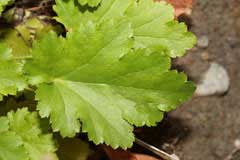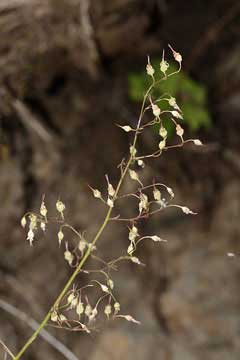 |
|
http://commons.wikimedia.org/wiki/User:Wsiegmund |
 |
| http://commons.wikimedia.org/wiki/User:Wsiegmund |
Translate this page:
Summary
Physical Characteristics

 Heuchera micrantha is an evergreen Perennial growing to 0.6 m (2ft) by 0.4 m (1ft 4in).
Heuchera micrantha is an evergreen Perennial growing to 0.6 m (2ft) by 0.4 m (1ft 4in).
See above for USDA hardiness. It is hardy to UK zone 5 and is not frost tender. It is in leaf all year, in flower from July to August, and the seeds ripen from August to September. The species is hermaphrodite (has both male and female organs) and is pollinated by Bees.
Suitable for: light (sandy) and medium (loamy) soils and prefers well-drained soil. Suitable pH: mildly acid, neutral and basic (mildly alkaline) soils. It can grow in semi-shade (light woodland) or no shade. It prefers moist soil.
UK Hardiness Map
US Hardiness Map
Synonyms
Heuchera micrantha diversifolia. (Rydb.)Rossend.Butters.&Lakela.
Plant Habitats
Woodland Garden Sunny Edge; Dappled Shade; Ground Cover; Cultivated Beds;
Edible Uses
Edible Parts: Leaves
Edible Uses:
Young leaves - cooked. Not very palatable[172].
References More on Edible Uses
Medicinal Uses
Plants For A Future can not take any responsibility for any adverse effects from the use of plants. Always seek advice from a professional before using a plant medicinally.
Antiphlogistic Antiseptic Astringent Febrifuge Ophthalmic Poultice
The root is antiphlogistic, antiseptic, astringent, febrifuge and ophthalmic[94, 172].
References More on Medicinal Uses
The Bookshop: Edible Plant Books
Our Latest books on Perennial Plants For Food Forests and Permaculture Gardens in paperback or digital formats.

Edible Tropical Plants
Food Forest Plants for Hotter Conditions: 250+ Plants For Tropical Food Forests & Permaculture Gardens.
More

Edible Temperate Plants
Plants for Your Food Forest: 500 Plants for Temperate Food Forests & Permaculture Gardens.
More

More Books
PFAF have eight books available in paperback and digital formats. Browse the shop for more information.
Shop Now
Other Uses
Hair Mordant
The root can be used as an alum substitute, this is a mordant used in fixing dyes[168, 172]. The root is rich in tannin, is this the active ingredient that acts as a mordant?[172]. A good ground cover plant for the woodland garden[200]. Plants should be spaced about 30cm apart each way[208].
Special Uses
Ground cover
References More on Other Uses
Cultivation details
Succeeds in any good sweet garden soil that does not dry out in spring[1]. Prefers full sun but tolerates partial shade[1, 111]. Prefers a well-drained fairly rich and not too heavy soil[111]. Plants are hardy to about -15°c[187]. Apt to hybridize with other members of this genus[111]. This species is probably best treated as a sub-species of H. micrantha.
References Carbon Farming Information and Carbon Sequestration Information
Temperature Converter
Type a value in the Celsius field to convert the value to Fahrenheit:
Fahrenheit:
The PFAF Bookshop
Plants For A Future have a number of books available in paperback and digital form. Book titles include Edible Plants, Edible Perennials, Edible Trees,Edible Shrubs, Woodland Gardening, and Temperate Food Forest Plants. Our new book is Food Forest Plants For Hotter Conditions (Tropical and Sub-Tropical).
Shop Now
Plant Propagation
Seed - sow early spring in a warm greenhouse and only just cover the seed. Germination is usually fairly rapid. Prick out the seedlings when they are large enough to handle and plant them out into their permanent positions in late spring or early summer. The seed can also be sown in the middle of spring in an outdoor seedbed and planted out in early summer. Alternatively, you can sow the seed in an outdoor seedbed in the middle of summer for planting out in the following spring. Division in March or October[1, 111]. It is best to divide the plants in August or early September, making sure that the woody roots are planted quite deeply with only the crown of foliage above the ground[233].
Other Names
If available other names are mentioned here
Native Range
NORTHERN AMERICA: Canada (British Columbia), United States (Oregon, Washington, California)
Weed Potential
Right plant wrong place. We are currently updating this section.
Please note that a plant may be invasive in one area but may not in your area so it's worth checking.
Conservation Status
IUCN Red List of Threatened Plants Status :

| Related Plants
|
| Latin Name | Common Name | Habit | Height | Hardiness | Growth | Soil | Shade | Moisture | Edible | Medicinal | Other |
| Heuchera americana | Rock Geranium, American alumroot, Alumroot, Coral Bells, Rock Geranium | Perennial | 0.5 |
4-9
| M | LM | SN | M | 0 | 3 | 2 |
| Heuchera cylindrica | Alum Root, Roundleaf alumroot, Alpine alumroot, Beautiful alumroot, Poker alumroot | Perennial | 0.5 |
4-8
| | LM | SN | M | 1 | 2 | 3 |
| Heuchera diversifolia | Alum Root, Crevice alumroot | Perennial | 0.6 |
4-8
| | LM | SN | M | 1 | 1 | 3 |
| Heuchera glabra | Alpine Heuchera | Perennial | 0.6 |
4-8
| | LM | SN | M | 1 | 1 | 3 |
| Heuchera sanguinea | Alum Root, Coralbells, Crimson Bells | Perennial | 0.5 |
4-10
| M | LM | SN | M | 0 | 0 | 3 |
| Heuchera versicolor | Pink alumroot | Perennial | 0.2 |
8-11
| | LM | SN | M | 0 | 1 | 3 |
|
Growth: S = slow M = medium F = fast. Soil: L = light (sandy) M = medium H = heavy (clay). pH: A = acid N = neutral B = basic (alkaline). Shade: F = full shade S = semi-shade N = no shade. Moisture: D = dry M = Moist We = wet Wa = water.
Now available:
Food Forest Plants for Mediterranean Conditions
350+ Perennial Plants For Mediterranean and Drier Food Forests and Permaculture Gardens.
[Paperback and eBook]
This is the third in Plants For A Future's series of plant guides for food forests tailored to
specific climate zones. Following volumes on temperate and tropical ecosystems, this book focuses
on species suited to Mediterranean conditions—regions with hot, dry summers and cool, wet winters,
often facing the added challenge of climate change.
Read More
Expert comment
Author
Rydb.
Botanical References
204
Links / References
For a list of references used on this page please go here
Readers comment
| Add a comment |
|
If you have important information about this plant that may help other users please add a comment or link below. Only comments or links that are felt to be directly relevant to a plant will be included. If you think a comment/link or information contained on this page is inaccurate or misleading we would welcome your feedback at [email protected]. If you have questions about a plant please use the Forum on this website as we do not have the resources to answer questions ourselves.
* Please note: the comments by website users are not necessarily those held by PFAF and may give misleading or inaccurate information.
To leave a comment please Register or login here All comments need to be approved so will not appear immediately.
|
Subject : Heuchera micrantha
|
|
|
|